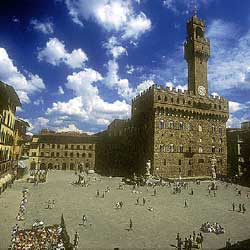|  The
site on which Piazza della Signoria was built was occupied in the period
of the Roman Florentia by a large theatre. In the Middle Ages, modest
houses and alleyways sprang up there. The land was the property of the
powerful Ghibelline family of the Uberti, and when the Guelphs took power,
they razed the Ghibelline properties to the ground and established that
nothing should be built on it again; this is the reason why Palazzo Vecchio,
which faces onto the piazza, is irregularly-shaped and both the main entrance
and the tower are somewhat eccentric. The
site on which Piazza della Signoria was built was occupied in the period
of the Roman Florentia by a large theatre. In the Middle Ages, modest
houses and alleyways sprang up there. The land was the property of the
powerful Ghibelline family of the Uberti, and when the Guelphs took power,
they razed the Ghibelline properties to the ground and established that
nothing should be built on it again; this is the reason why Palazzo Vecchio,
which faces onto the piazza, is irregularly-shaped and both the main entrance
and the tower are somewhat eccentric.
Work on the piazza, which was designed and supervised by Arnolfo di
Cambio, started in 1299 and since then has witnessed all the major changes
in the history of the city. Like Palazzo Vecchio, its name has changed
a number of times: initially called "Piazza dei Priori" or "Piazza
dei Signori", it was renamed "Piazza del Granduca" during
the government of Cosimo I, and maintained this name till 1859 when the
Grand Duchy finally collapsed. Since the unification of Italy, it has
had its current name of Piazza della Signoria.
Besides the name, the perimeter and the paving of the piazza have also
changed several times. When Palazzo Vecchio was enlarged, a number of
houses were destroyed or moved back in order to maintain the size of the
piazza. At the beginning there was simply a dirt surface, then it was
paved in red brick and finished with pietra serena. This lasted until
the nineteenth century when it was resurfaced entirely in pietra serena.
This nineteenth century surface was largely replaced with new pietra serena
paving a few years ago, which sparked off a polemical dispute between
the Florentines and the bodies responsible for the work, not only because
of the appearance of the 'patch job' but also because the old stones mysteriously
'disappeared'…
The piazza was embellished in 1563 with the Neptune Fountain by Ammannati
(known by Florentines as the "Fontana del Biancone") and in1590
the Equestrian Monument to Cosimo I de' Medici by Giambologna was positioned
to the right of Palazzo Vecchio.
In 1420, on the extreme right of the main facade of Palazzo Vecchio, The
Marzocco by Donatello (now a copy) was displayed as a symbol of the strength
and liberty of the comune, while the famous David of Michelangelo (now
also a copy) was positioned to the side of the main doorway to symbolise
the victory of democracy over tyranny. Bandinelli's Hector and Cacus,
dated 1534, was placed near the David to recall the victory of the Medici
over their internal enemies. Close to the centre of the piazza there is
a circular plaque with an inscription which indicates the point where
Savonarola was burnt at the stake.
Picture by Sandro Santioli
Translated by Jeremy Carden
|